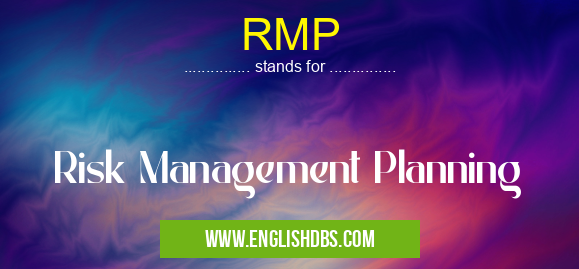What does RMP mean in MANAGEMENT
Risk Management Planning (RMP) is a process of assessing, analyzing and mitigating risks associated with any project or endeavor. It is an important component of successful business management as it helps to identify and address areas that could lead to failure or loss. RMP involves developing strategies for dealing with potential risks in order to minimize their impact on the organization. The goals of RMP include reducing the cost of risk, ensuring safety and security, ensuring compliance with applicable regulations and laws, maintaining quality standards and improving customer satisfaction.

RMP meaning in Management in Business
RMP mostly used in an acronym Management in Category Business that means Risk Management Planning
Shorthand: RMP,
Full Form: Risk Management Planning
For more information of "Risk Management Planning", see the section below.
» Business » Management
Goals
The primary goal of Risk Management Planning is to identify, analyze and manage sources of risk before they can cause damage or harm to the organization. This includes proactively evaluating current practices, implementing controls to reduce risk exposure, monitoring changes in the environment that could create new risks and updating plans accordingly. Additionally, RMP should incorporate strategic planning to ensure that risks are being properly managed and that priorities are set for future actions. This also allows organizations to better anticipate potential problems by understanding their own vulnerabilities when it comes to external forces such as competitive markets or financial conditions.
Benefits
The benefits of a comprehensive Risk Management Plan are numerous. By taking proactive steps in identifying and managing risks, organizations can save money by avoiding losses due to costly mistakes or unforeseen circumstances while also preserving their moral integrity in the eyes of stakeholders. Additionally, having a well-thought-out plan can improve communication between stakeholders, help build trust among team members, increase employee morale and ultimately lead to increased productivity within the organization due to mitigation of both physical and psychological stress caused by worrying about unanticipated events.
Essential Questions and Answers on Risk Management Planning in "BUSINESS»MANAGEMENT"
What is Risk Management Planning (RMP)?
Risk Management Planning (RMP) is a systematic process of identifying and evaluating potential risks associated with a project, developing strategies to minimize and manage those risks, and planning for the most effective response if and when those risks materialize.
What does an RMP include?
An RMP includes the identification of potential risks, risk assessment, analyzing and prioritizing risks, developing strategies to mitigate or control the risks, monitoring risk mitigation activities and review/refine plans.
What are some best practices when it comes to Risk Management Planning?
Best practices when it comes to Risk Management Planning include actively engaging stakeholders in all stages of the process, continuously monitoring the identified risks, remaining flexible and adapting strategies as needed to adjust to changes in risk environment over time.
Why is RMP important?
Risk Management Planning is important because it helps organizations identify potential areas of concern that could affect project success before they become an issue, allowing them to proactively manage these risks through various strategies from avoidance to transfer. This helps reduce uncertainty associated with projects as well as improving overall performance by reducing potential negative impacts.
What are the different steps involved in RMP?
The different steps involved in RMP include risk identification, risk assessment analysis, risk prioritization, development of mitigation/response plans as well as evaluation & review/refinement of plans over time.
How should organizations prioritize their identified risks?
Organizations should prioritize their identified risks according to their likelihood of occurrence and degree of impact on project objectives. In other words, determining which ones have the highest likelihood of occurring should be given higher priority than ones that are less likely but more severe in terms of impact.
Final Words:
A well implemented Risk Management Plan has immense benefits for any organization as it helps identify high-risk areas so they can be appropriately addressed before they result in any actual losses or damages. The goals behind this process help ensure costs are minimized while enhancing customer satisfaction as well as mitigating legal liabilities related to environmental regulations or other laws. Through effective implementation of this process organizations have a better chance at achieving success in whatever endeavors they pursue while having more peace of mind knowing that their business is secure from unforeseen disasters.
RMP also stands for: |
|
| All stands for RMP |
